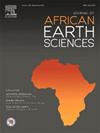伊拉克库尔德斯坦地区Bijeel - Aqra地区构造新发现:对油气勘探和成熟的启示
IF 2.2
4区 地球科学
Q2 GEOSCIENCES, MULTIDISCIPLINARY
引用次数: 0
摘要
阿克拉镇南部地区;伊拉克库尔德斯坦地区以丘陵地貌和低山地地形为特征;这个地区有许多油田,是一个很有前途的油区。研究中广泛暴露的岩石属于白哈桑组(上新世—更新世),较老的岩石很少暴露,并且局限在一些背斜的核心内,特别是在大扎布河以东。该地区的经济重要性要求进行更新的构造调查,并附有可能构成石油系统及其组成部分的潜在岩石单元。进行的结构研究使用了高质量的卫星图像(ESSRI, 2013)。ArcGIS REST服务目录)来推断研究区域的结构形式。通过地层评价,确定了研究区含油气系统的组成要素。研究区域以前已知只有四个背斜(Bijeel, Rovia, Sarta和Bawakhan背斜),这些背斜被描述并绘制在地质图上。然而,在目前的研究中,发现了6个背斜;它们从北到南依次是:Bijeel、Mamandok、Grdashin、Rovia、Sarta和Bawakhan背斜,所有这些构造都在实地考察中得到了核实。最近发现的背斜的轴线及其准确位置和延伸的圈定,将提供有趣的数据,特别是对石油勘探活动,并可能增加进一步的储层发现。潜在含油气系统的定义有助于指出构成含油气系统各要素的地层单元(地层):烃源岩、储层和封闭岩。本文章由计算机程序翻译,如有差异,请以英文原文为准。

New structural findings in Bijeel - Aqra vicinity, Kurdistan region of Iraq: Insight into oil exploration and hydrocarbon maturation
The southern vicinity of Aqra town; Iraqi Kurdistan Region is characterized by hilly morphology and low mountainous relief; this area is a promising oil district with many oil fields. The widely exposed rocks in the study belong to the Bai Hassan Formation (Pliocene – Pleistocene), older rocks have rare exposures and are restricted within the core of some anticlines, especially east of the Greater Zab River. The economic importance of this area mandates updated structural investigations accompanied by the potential rock units that may comprise the petroleum systems and their elements. The performed structural study used high-quality satellite images (ESSRI, 2013. ArcGIS REST Services Directory) to deduce the structural forms in the studied area. A stratigraphic appraisal of the geologic formations was also conducted to define the elements of petroleum systems of the study area. The study area was previously known to have only four anticlines (Bijeel, Rovia, Sarta, and Bawakhan anticlines), which were described and plotted on geological maps. Whereas, in the current study, six anticlines were recognized; they are from north to south: Bijeel, Mamandok, Grdashin, Rovia, Sarta, and Bawakhan anticlines, all these structures were verified upon checking field visits. The delineation of the axes of the recently recognized anticlines with their accurate locations and extensions, will furnish interesting data, especially, for oil exploration activities, and may add further reservoir discoveries. The definition of potential petroleum systems facilitated pointing out the stratal units (formations) that can make each element of the petroleum systems: source, reservoir, and sealing rocks.
求助全文
通过发布文献求助,成功后即可免费获取论文全文。
去求助
来源期刊

Journal of African Earth Sciences
地学-地球科学综合
CiteScore
4.70
自引率
4.30%
发文量
240
审稿时长
12 months
期刊介绍:
The Journal of African Earth Sciences sees itself as the prime geological journal for all aspects of the Earth Sciences about the African plate. Papers dealing with peripheral areas are welcome if they demonstrate a tight link with Africa.
The Journal publishes high quality, peer-reviewed scientific papers. It is devoted primarily to research papers but short communications relating to new developments of broad interest, reviews and book reviews will also be considered. Papers must have international appeal and should present work of more regional than local significance and dealing with well identified and justified scientific questions. Specialised technical papers, analytical or exploration reports must be avoided. Papers on applied geology should preferably be linked to such core disciplines and must be addressed to a more general geoscientific audience.
 求助内容:
求助内容: 应助结果提醒方式:
应助结果提醒方式:


